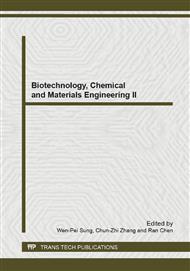[1]
Jerry.P. Byers: Metalworking fluids(Chemical Industry Press, Beijing 2011).
Google Scholar
[2]
ASADAUSKAS S., PEREA J.M. and DUDA J.L.: Suitability of base stocks for biodegradable lubricants. Prepr-Am Chem Soc Div Pet Chem. 41(1997), pp.246-255.
Google Scholar
[3]
LI Jinfang, Li Bin and Si Lili: metal cutting fluid environment behavior analysis and evaluation. Internal combustion engine and power plant. 1(2009) , pp.89-92.
Google Scholar
[4]
EISENTRARGER A, SCHRMIDT M , MURRENHOFF H, Et al: Biodegradability testing of synthetic ester lubricants-effects of additives and usage. Chemosphere. 48(2002) , pp.89-96.
DOI: 10.1016/s0045-6535(02)00084-x
Google Scholar
[5]
GAO Jun , CHEN Boshui , ZHAO Guangzhe, et. al: the general situation of the development of biodegradable lubricants. chemical industry and engineering technology. 29(2008), pp.1-3.
Google Scholar
[6]
Carolyn Boggus Duncan U.S. Patent5, 728, 658. (1998).
Google Scholar
[7]
WU Zhiqiao , XIN Tian , HAN Sheng : green environmental protection metal cutting fluid research progress. Shanghai chemical industry. 36(2011), pp.29-34.
Google Scholar
[8]
ARNSEK A , VIZINTIN J: Lubricating properties of rapeseed-based oils, J. Syn Lubr. 16 (1999) , pp.281-296.
Google Scholar
[9]
Blaser International Trading (Shanghai) Co., Ltd.: improve cutting performance of plant oil cooling fluid. modern metal processing. 12(2005) , pp.66-67.
Google Scholar
[10]
P . BROWN: Synthetic Base Stocks(Groups IV and V)in Lubricant Applications. Lubr Eng. 66 (2000) , pp.33-39.
Google Scholar
[11]
LI Qinghua: new vegetable oil modified embellish agent research and development(2009).
Google Scholar
[12]
YE Bin: new modified vegetable oil and environmental friendly lubricant tribological performance was applied research(2002).
Google Scholar
[13]
SHARMA B.K., ADHVARY L.A., LIU Z., Et al: Chemical modification of vegetable oils for lubricant applications. JAm Oil Chem Soc. 83( 2006) , pp.129-136.
DOI: 10.1007/s11746-006-1185-z
Google Scholar
[14]
WANG Bin: Two kind of new environmental friendly lubricants and lubricity and applied research(2005).
Google Scholar
[15]
LI Cunyan, LI Weimin, GUODengfeng, et. at : castor oil processing and application progress. Grain and oil processing. 40(2010) , pp.16-19.
Google Scholar
[16]
Information on http: /www. agri. ac. cn/news/2008521/45444. html.
Google Scholar
[17]
WANG Huaiwen, LIU Weimin: Vegetable oil as the general situation of the study of environmental friendly lubricant . lubrication and sealing. 29( 2004) , pp.127-130.
Google Scholar
[18]
LI Huan, LIU Hongyan , WANG Shujun, et. al: corn oil type sulfur lubricating oil additive synthesis and performance evaluation. lubrication and sealing. 35(2010), pp.102-105.
Google Scholar
[19]
DUNCAN C.B. ,MEADE L.K., U.S. Patent5, 728, 658. (1997).
Google Scholar
[20]
ZHANG Yongquan: for formulating" the synthetic ester type heavy duty industrial gear oil "standard discussion . China standardization. 8(2011)7, pp.3-75.
Google Scholar
[21]
LI Wei, MA Tao, LIN Guangshan, et. al: Water-based metal cutting fluid present research and the development trend of. tool technology. 44(2010), pp.6-9.
Google Scholar
[22]
UOSUKANEN E., LNKOY Y., LAMSA I., Et al: Transesterification of Trimethylolpropane and rapeseed oil methyl ester to environmentally acceptable lubricants . J Am Oil Chem Soc. 75( 1998) , pp.1557-1563.
DOI: 10.1007/s11746-998-0094-8
Google Scholar
[23]
HALLBERG M.L., WANG Daobin , HARROD M.: Enzymatic synthesis of wax esters from rapeseed fatty acid methyl esters and a fatty alcohol. J Am Oil Chem Soc. 76( 1999) , pp.183-187.
DOI: 10.1007/s11746-999-0216-y
Google Scholar
[24]
LINKOY Y., TERVAKANGA S.T., LAMSA M., Et al: Production of trimethylolpropane esters of rapeseed oil fatty acids by immobilized lipase. Biotechnology Techniques. 11( 1997) , pp.889-892.
Google Scholar
[25]
YUNUS R., LYE O. T., A. FAKHRU' L- RAZI, Et al: A simple capillary column GC method for analysis of palm oil- based polyol esters. J Am Oil Chem Soc. 79( 2002) , pp.1075-1080.
DOI: 10.1007/s11746-002-0606-3
Google Scholar
[26]
BELL E.W., COWN J.C., GAST L.E.: Potential lubricants for continuous casting of steel polyolesters of partially hydrogenated soybean acids. Jam Oil Chem Soc. 49(1972)552- 554.
DOI: 10.1007/bf02609224
Google Scholar
[27]
HONG Ting: cutting fluid in polymerization ester replaced the performance of chlorinated paraffin. lubricating oil. 23(2010) , pp.39-44.
Google Scholar
[28]
ZHANG Jinghe, ZHANG Juntao, LIANG Shengrong, et, al: PAO lube base oil experiment performance and application trends. lubricating oil and fuel. 16(2006), pp.1-7.
Google Scholar
[29]
MOORE L.D. , FELS D.R., SEAR A.B., Et a1: PAO—Based Synthetic Lubricants in industrial Applications. Tribology & Lubrication Technology. 59(2003) , pp.23-24.
Google Scholar
[30]
LI Tao: Multi-purpose polyethylene glycol product market and application. petrochemical technology and economy. 26(2010), pp.24-29.
Google Scholar


